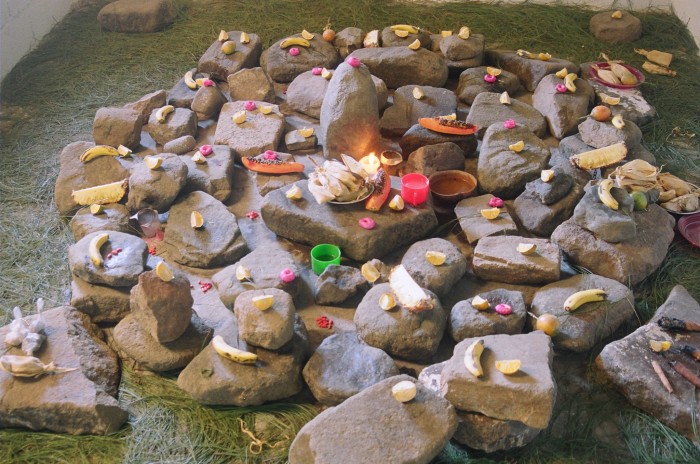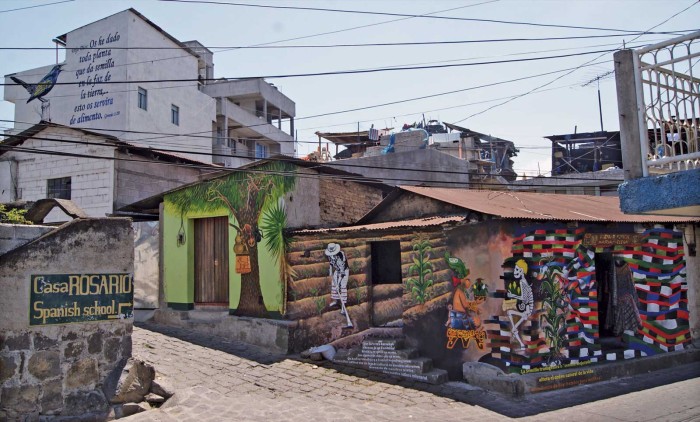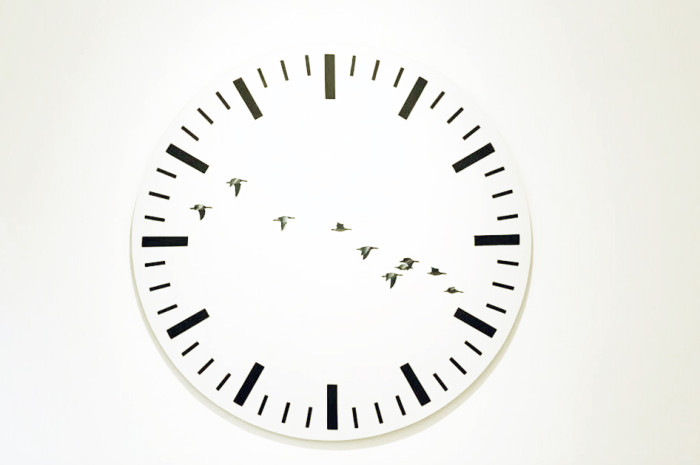
08.06.2015
Every object produced by men is a demonstration of our helplessness against nature. By assigning imaginary values to nature and building systems with them, we become objects of our own constructions. Are numbers objects ? Is our breath the object of words?
 Edgar Calel and Rosario Sotelo, Untitled, 2013. Installation with fruits, rocks, candles. San Juan Comalapa, state of Chimaltenango, Guatemala. Artwork recipient of the Price Juannio 2015.
Edgar Calel and Rosario Sotelo, Untitled, 2013. Installation with fruits, rocks, candles. San Juan Comalapa, state of Chimaltenango, Guatemala. Artwork recipient of the Price Juannio 2015.
But things don’t have a name nor personality:
they exist and the sky is grand and earth is wide
and our hearts the size of a fist…
Alberto Caeiro
I received an invitation to write about “The Things” in the second edition of Terremoto. I stare at the screen for a moment, this delta of signs: of what and to whom? Facts and things have become remote in front of this amorphous and flickering reflection of the “river of information.” I think of things seen as fetishes, and of course art needs a constant supply of it. It’s a market constructed precisely with this end, to convert the privilege of observation into private property, giving a series of objects made as an expression of individuality a particular historic value.
Nevertheless, everyday life is resolved among other things: tools, clothes, the raw material’s market, thousands of man-made products made in a series to which we don’t search for their meaning. Here is where true fetishism hides: in the cult of the cell phone, the watch, the computer, the automobile. These are objects that are offered up and acquired under the slogan of being necessary and useful, and at the same time imply the idea of joy, since they have been designed according to one vision of the world, of value codes and lifestyles. The difference is that we have been snatched from the capacity to decide over these things, and their meanings are given beforehand. Along with the technological innovations, we also buy the software and therefore we behave as the dynamo that keeps the market working.
Yet, art and utensils aren’t everything. It’s been almost a century since Max Horkheimmer and Theodor Adorno warned us about the lack of freedom that mass cultural mystification would lead us to, and later on, J.F. Lyotard noted the approximation of language and merchandise. What is that which we acquire through magazines, web pages, and TV programs? It is necessary that we try to clarify the implications of publicity from language’s structure, to expose what it says and dare to formulate these things by our own terms.

 Community-based, educational intervention in public space (to denounce problems linked to the use of transgenic seeds) under the direction of visual artist Manuel Chavajáy, 2014. District of San Pedro la Laguna, state of Sololá.
Community-based, educational intervention in public space (to denounce problems linked to the use of transgenic seeds) under the direction of visual artist Manuel Chavajáy, 2014. District of San Pedro la Laguna, state of Sololá.
Old and New Metaphysics
Perhaps one of the most prolific problems stated by the Western thought is precisely the search for the “object.” Words such as “being,” “existing,” “substance,” “essence,” “form,” and “numen” are some of the solutions proposed by several thinkers throughout history, without reaching a universal agreement. The original question of the Greek philosophers, “What is being?” appears a rhetorical one today. The structure becomes its own warning. In that attempt of a universal abstraction, there’s an artificial distancing from reality. How could we doubt nature all that’s perceived? The original question must have been something lived without categories or generalizations; something that was formulated by the first individual that became aware of how far he was from nature and how society was limiting him. What or who am I? To question the meaning of our own lives is the birth of all metaphysics, and therefore we begin to consider “objects” the things that only exist, and so we interpret them. Be it through mathematical equations, where we divide the world in atoms, or simply speak about the reason of things in relation to their purpose, the individualistic point of view is the one that makes sure to give consciousness a frame, a structure.
Western philosophy has always criticized the magical thought for its lack of objectivity, of confusion between the shaman’s “imaginary objects” and nature’s forces that he pretends to control through rituals. Yet the strongest difference, after many thousands of years of development, doesn’t reside solely in science and technology developed by the West. Naming the world is already an attempt of owning it, and through ecstasy, in which the mantra dissolves in language, the priest updates his consciousness facing the world. The Western scientist continues alone in his path, searching each time for greater abstractions, grading the problem of the origin and the purpose as metaphysics.
Each time the West reaches this limit where science, law or technology are proven insufficient, it turns to individual consciousness as refuge in order to understand reality. As Rome’s political continuity ends, Saint Augustin of Hipona builds from the faith of a “City of God,” linked to a personal salvation – a new historical conception of Christianity. This faith is then divided with Luther, thus Europe goes through a long period of religious wars and Descartes delves into doubt to renovate modern liberty, suggesting the individual psyche as the absolute principle. Old monarchies are later destroyed, and technology becomes a machine for extermination. Consequently, attention is directed towards logic: Husserl, Wittgestein, and Russel recognize that there must be an error in the valuation of the categories, in the transmission of knowledge. Even if the signs support the material existence, what we understand in them is nothing more than “the will” that’s being negotiated, the intentions that are hypocritically manifested, “the discursive stadium” that changes. If there is something left of metaphysics, it is linked to semiotics and the considerations towards the nature of language, impulsed by the corrosive capacity developed by communication’s media in the past century.
 Angel Poyón, Less time than space, 2013. The work is an evocation of the rain that indicates the beginning of the sewing time.
Angel Poyón, Less time than space, 2013. The work is an evocation of the rain that indicates the beginning of the sewing time.
The Reality of Signs
Language is a collective creation where each of us has learned the meaning of words by imitation, and it is rare to ponder the profound meaning of each term we use, which is rooted in history. Each word is associated to another constellation of meanings, and this relationship is culturally determined by the generations that have come before us.
It is only through this line of thought that we can attribute an objective existence to words, numbers, and other symbol systems. They exist because they have a meaning that holds up collectively, while serving as support for identities and socially constructed categories. Looking at it objectively, it is not ourselves that think of meanings but rather society and history, which drives itself through us. Without society, a dictionary or moral code that confirms our interpretation, the symbol ceases to exist as abstraction and it turns into a strange gesture, a psychological fact, a piece of archeology or a work of art. It becomes something that requires a special form of interpretation.
Yet the object is not the only one to enjoy this undetermined status. If nominalism has contributed to something in the past century, it is making us see how difficult it is to find the exact content in adjectives, pronouns, and names. Since there can’t be a universal definition for any of these words: soft warm, difficult, they only have a sense of comparison to other things. The same can be said about pronouns and names: me, them, Julius, Charles, any one who names themselves or others is a participant of the social mechanism that allows order and fluency of discourses, but leaves out the particular experience of the individual. In each case, whoever says “me” is referencing a context that defines him from the outside, to a peculiarity which the reach is ignored. He who writes a name is addressing that identity shaped by its own experience. Even the toponymies of places have a different meaning depending on who mentions it. Is there such a place called Istanbul, Egypt, Guatemala? I think of Umberto Eco and the diverse purposes he finds for the expression, “This man comes from Basora”(The Open Work, 1962).
Along the way, we assume these peculiarities and generalizations that we can point out, some differences between Western thinking and how to conceive some vagueness within autonomous forms such as Mayan cosmovision.

 Marilyn Boror, To not forget their names, 2013. Urban intervention about the conservation of the kaqchikel language.
Marilyn Boror, To not forget their names, 2013. Urban intervention about the conservation of the kaqchikel language.
The I
An exception to organic and genetically determined manifestations, our own conduct and self-perception are conditioned from childhood. The “I” is a social construct, and personality is a result of language. However, the act of understanding is a psychological one forged from individual will, yet tied to that common fund called knowledge.
Now, every experience that happens to an individual is subjective. Why should we have to pretend its universality? From his phenomenology of spirit, Hegel suggests a search for the infinite, that encounter with “the Other” is a moment that is resolved in a death fight. This idea comes up again with Nietzsche and Stuart Mill, and it is what Paul Ricoeur debates in his book Oneself as Another. The individual consciousness is placed precisely in this sea of will that precedes and surpasses us, which doesn’t resolve the struggle. The assertion of oneself in front of the world doesn’t need to signify the suppression of the other, while assuming it as an integral part of my identity. It demands forms of socialization and even pleads for aid to overcome the problem.
This problem is typically occidental, since in other cultures the Oneself is viewed as something dispersed. Think of the fake funerals of Africa’s Yoruba chiefs, in which they don’t speak of a physical death of the king. Rather they talk about the divine spirit that sustained him, or the diversity of spirits that converge the formation of Oneself within the cities of Meso and South America.
In Mayan cosmovision, each individual is fixed to at least four spirits that will guard him for life. Far from provoking a “dissociated personality,” as it might be interpreted from Western psychology, this position fulfills the interrogative function, where each individual must search in these qualities the one to cultivate despite the adversities. It does not work exactly as the astral cards, because each spirit reigns over one aspect of life, and its influence also extends to collective history in a way that one can always count with the people with whom these inclinations are shared, thus finding his place in the world. Ideally a society could be organized into a community according to the spiritual characteristics that define the individuals.
Time
From a Christian perspective it is easy to think of predestination, but we must remember that 20 days exist, each one with a specific “nahual” (spirit). Over these exist some 13 months (winales) that signify a “lifter,” which would be the second spirit. At the end of each year (tun), made up of 18 months, it would connect to a larger cycle of 20 years (kátun), (<correct spellling – differs from spelling of thr word in next line?) that would signal a third one that joins the ritual calendar of 20 k’atunes, hence naming the fourth. Giving the complexity of the Mayan calendar, dates might repeat themselves once every 5,125 years, and upon this cycle the ruling spirit would be another one. This is how the “will of the infinite” disappears, because even if each one has a turn within the shortest cycles of 20 years, the fulfillment of the spirit that pushes each of the widest cycles would be too long to wait for the spirit to archive it in one lifetime.
As it’s told by Husserl: “Everything that exist in time is necessarily a thing, that contributes to the building of things.” The Western concept of time inherited from the Judo-Christian tradition is linear. Hence everything is destined to disappear. Yet both Islam and Christianity preserve within their mythologies an end of history that’s linked to the assertion of the divine will – the moment where all humanity will be judged.
History perceived this way, makes existence into a passage of scarcity that may appear as an unnecessary condemnation.
The oldest cyclical conceptions, as Zoroastrianism from which Christianity has appropriated its apocalyptic vision, does not imply a repetition of the historical incidents rather than a natural acceptance of death and regrowth.
Both in Hinduism and Mesoamerican cosmovisions, humanity’s history is just one part of universal history. Eternity remains incomprehensible, yet man assumes himself as part of nature, where history proceeds him, and which evades the problem of placing man as the center of history and the measure of all things.
Note: many of these words do not to be placed in quotations for context. I removed at various places which I found unnecessary to the reader.

 Community-based, educational intervention in public space (about recuperation of historical heritage) under the direction of visual artist Manuel Chavajáy, 2014. District of San Pedro la Laguna, state of Sololá.
Community-based, educational intervention in public space (about recuperation of historical heritage) under the direction of visual artist Manuel Chavajáy, 2014. District of San Pedro la Laguna, state of Sololá.
The Abstraction
The way the Mayan cosmovision has been distributed through its popular version, “nahual” is a spirit that is materialized into an animal, a guardian to a person or a place, (rivers, mountains, ravines, are considered live beings). However, this is not precisely right. Someone can accept a spirit, even if it is not one of the spirit guides that he was brought up with. A “nahual” can also be an object, a date or a word. In any case, “nahual” would designate an energy’s form of expression to which a subject identifies with.
Note: The word nahual does not need to be both italicized and in quotations. I placed in quotations throughout to keep consistent.
The influence of the “nahuales” and “lifters” is perceived linearly, even if time is cyclical, because they have a historic continuity determined by the cyclical repetition of the number of months, days, and k’atunes. The influence of the “nahuales” and the numbers can be related to the ten sephirot in Judaism. Each time period influences over an organ and one aspect of life. This is why some days are adequate for certain activities, but it can vary from one person to another.
The word is mentioned in the “Popol Vuh” as the beginning of time and the origin of the universe, when the three creators of the heavens came to an agreement and discussed among themselves. In the original manuscript, this instance is described with the term “tzijój.” “Tzij” in ancient Mayan means word, and “oj” is the superlative that can be interpreted as creator. Currently in Mayan language “tzij” would mean emanation (an example is “có-tzij,” meaning flower). This way, every object and living thing created in that first instance of the arrangement time is a sacred thing. It is us who create objects through another act called “aj,” and that translates as an expression of individual will.
The direct way of communication with destiny, besides calculation, lies in fire rituals. The priest usually prays to the spirits that correspond to the date, asks for help specially to his spirit guides and tries to interpret the fire, the “happening-thing” closest to the energy, to understand the answer that they can give us.
Comments
There are no coments available.